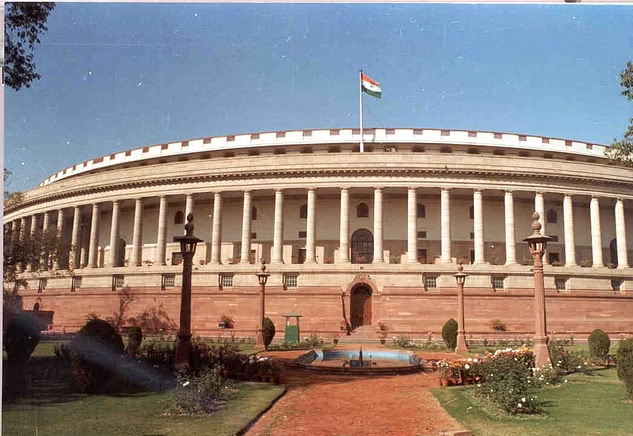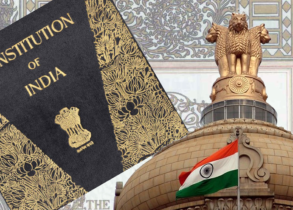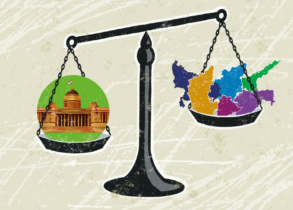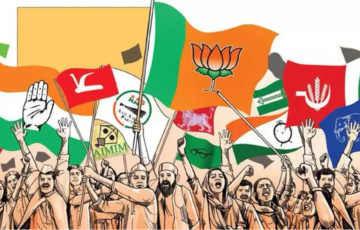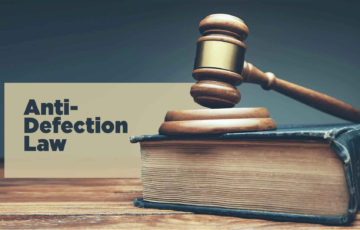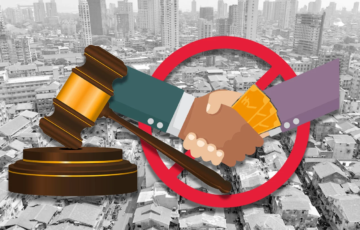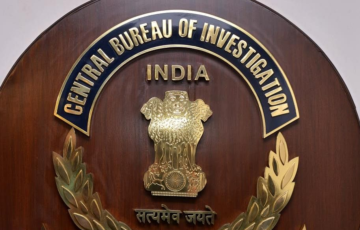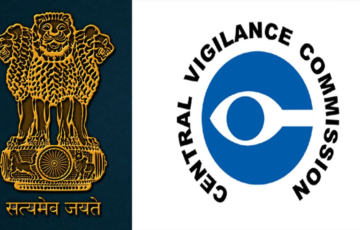PARLIAMENTARY SYSTEM
Introduction
- The Indian Constitution establishes a parliamentary form of government, both at the Centre and in the states. Articles 74 and 75 address the parliamentary system at the Centre and Articles 163 and 164 in the states. Modern democratic governments are classified into parliamentary and presidential systems based on the relationship between the executive and legislative organs. The parliamentary system, also known as cabinet government or responsible government, is prevalent in Britain, Japan, Canada, and India. The presidential system, also known as non-responsible or non-parliamentary, is prevalent in the USA, Brazil, Russia, and Sri Lanka.
- Ivor Jennings called the parliamentary system the ‘cabinet system’, as the cabinet is the nucleus of power in a parliamentary system. The parliamentary system is also known as the ‘Westminster model of government’, named after the British Parliament, where the parliamentary system originated. In the past, the Prime Minister was described as ‘primus inter pares’ (first among equals) in relation to the cabinet. However, in recent times, the Prime Minister’s power, influence, and position have increased significantly, making him a dominant figure in the British politico-administrative system.
Features of Parliamentary Government
- Distinction Between Nominal and Real Executives: The President holds the position of the nominal executive, often referred to as the de jure executive or titular executive. In contrast, the Prime Minister serves as the real executive, also known as the de facto executive. This demarcation designates the President as the head of the State, while the Prime Minister assumes the role of the head of the government. Under Article 74 of the Constitution, a council of ministers, led by the Prime Minister, is established to provide counsel and guidance to the President in the exercise of their duties. It is important to note that the advice tendered by the council of ministers is legally binding on the President.
- Governance by the Majority Party: The political party that secures the majority of seats in the Lok Sabha forms the government. The leader of this majority party is appointed as the Prime Minister by the President. Other ministers are appointed by the President upon the recommendation of the Prime Minister. In cases where no single party attains a majority, the President may extend an invitation to a coalition of parties to establish the government.
- Collective Responsibility as the Cornerstone: The principle of collective responsibility is the cornerstone of the parliamentary system of government. Ministers within the council of ministers are collectively accountable to the Parliament as a whole and, specifically, to the Lok Sabha, as stipulated in Article 75. These ministers function as a cohesive unit, sharing both successes and failures. The principle of collective responsibility implies that the Lok Sabha can dismiss the ministry, including the council of ministers led by the Prime Minister, by passing a vote of no confidence.
- Political Consistency: In most instances, members of the council of ministers belong to the same political party, reflecting a shared political ideology. In the case of a coalition government, ministers are bound by consensus and work towards a common agenda, emphasizing cooperation among diverse political entities. This political homogeneity or collaborative spirit is crucial for the smooth functioning of the government and the fulfillment of its responsibilities.
- Dual Membership of Ministers: Ministers in a parliamentary system of government hold a unique dual role as members of both the legislature and the executive. This essentially means that an individual cannot assume the position of a minister without first being a member of the Parliament. The Constitution explicitly states that any minister who ceases to be a member of the Parliament for a continuous period of six months automatically relinquishes their ministerial position.
- The Leadership Role of the Prime Minister: In this system, the Prime Minister assumes a paramount leadership role. The Prime Minister serves as the leader of the council of ministers, the leader of the Parliament, and the leader of the political party in power. In these capacities, the Prime Minister plays a pivotal and highly influential role in the effective functioning of the government.
- Dissolution of the Lower House: In a parliamentary system, the lower house of the Parliament, such as the Lok Sabha, may be dissolved by the President upon the recommendation of the Prime Minister. In practical terms, this means that the Prime Minister can advise the President to dissolve the Lok Sabha prior to the expiration of its term, leading to the conduct of fresh elections. This authority grants the executive the power to seek the dissolution of the legislature, contributing to the flexibility and adaptability of the parliamentary system.
- The Principle of Secrecy: Ministers in a parliamentary system adhere to the vital principle of secrecy in their proceedings. This implies that they are bound not to disclose information regarding their discussions, policies, and decisions. Before assuming their responsibilities, ministers take an oath of secrecy, administered by the President. This commitment to secrecy is fundamental to maintaining the confidentiality and integrity of government operations and deliberations.
Features of Parliament
- Separation of powers:The executive, legislative, and judicial branches of government are separate and have their own powers and responsibilities.
- Head of state and head of government: The president is both the head of state and the head of government. This means that the president is the highest-ranking official in the country and is also responsible for leading the government.
- Direct election of the president:The president is elected directly by the people. This means that the people have a direct say in who leads their country.
- Fixed term of office:The president has a fixed term of office, which cannot be shortened by the legislature. This gives the president stability and independence.
- Veto power: The president has the power to veto legislation passed by the legislature. This means that the president can prevent laws from being passed if he/she disagrees with them.
- Appointment power:The president has the power to appoint cabinet members, judges, and other high-ranking officials. This gives the president a great deal of control over the government.
- Commander-in-chief:The president is the commander-in-chief of the armed forces. This means that the president has the power to deploy the military and to declare war.
- The presidential system of government is used by a number of countries around the world, including the United States, Brazil, and Mexico.
| Advantages and Disadvantages of the Presidential System of Government |
Advantages:
Disadvantages:
Overall, the presidential system of government is a system of government with both advantages and disadvantages. It is important to weigh the pros and cons of the presidential system before deciding whether or not it is the right system of government for a particular country. |
Merits of Parliamentary System
- Accountability: The government is accountable to the legislature, which is elected by the people. This means that the people have a say in who leads their country and can hold the government accountable for its actions.
- Flexibility: The parliamentary system is more flexible than other systems of government, such as the presidential system. This is because the government can be removed from office at any time by a vote of no confidence in the legislature. This can help to prevent the government from becoming too powerful or unresponsive to the needs of the people.
- Stability: The parliamentary system can provide for a more stable government than other systems of government. This is because the government is likely to enjoy a majority in the legislature, which gives it the stability to govern effectively.
- Checks and balances: The parliamentary system has a number of checks and balances in place to prevent any one branch of government from becoming too powerful. For example, the legislature can remove the government from office by a vote of no confidence, and the judiciary can review the government’s actions to ensure that they are lawful.
- Representation: The parliamentary system is more representative than other systems of government. This is because the legislature is elected by the people, and the government is drawn from the legislature. This means that the government is more likely to represent the diversity of the population.
- In addition to these general merits, the parliamentary system of government has also been shown to be effective in promoting economic growth and development. Studies have shown that countries with parliamentary systems tend to have higher rates of economic growth and development than countries with other systems of government.
Demerits of Parliamentary System
- Gridlock: The separation of powers between the executive and legislative branches can lead to gridlock, where the two branches of government are unable to agree on legislation. This can make it difficult to get things done in government.
- Deadlock:If the executive and legislative branches are controlled by different parties, it can be difficult to get anything done, as the executive can veto legislation passed by the legislature. This can lead to a deadlock in government.
- Abuse of power:The prime minister and the cabinet have a lot of power, and if they are corrupt or abusive, they can use their power to harm the people.
- Instability:The government can be removed from office at any time by a vote of no confidence in the legislature. This can lead to instability in government.
- Dominance by one party:If one party enjoys a large majority in the legislature, it can dominate the government and make it difficult for other parties to play a meaningful role.
- Corruption: The prime minister and the cabinet have a lot of power, and this can lead to corruption.
- In addition to these general demerits, the parliamentary system of government has also been criticized for being slow and inefficient. This is because the government needs to get the approval of the legislature before it can take action. This can make it difficult for the government to respond quickly to crises or to implement new policies.
Why India Adopted Parliamentary System?
- India adopted a parliamentary system of government for several reasons, rooted in its historical and political context. The decision to adopt this system can be attributed to the following key factors:
- British Colonial Legacy: India was a British colony for nearly two centuries, and the British colonial administration heavily influenced its political institutions and governance structures. The British parliamentary system served as a model for India’s post-independence government.
- Familiarity and Experience: Many leaders of the Indian independence movement were well-versed in the workings of the British parliamentary system. Prominent figures like Jawaharlal Nehru, who became India’s first Prime Minister, had experience with parliamentary politics.
- Democratic Values: India, after gaining independence in 1947, aspired to be a democratic republic. The parliamentary system was seen as a way to uphold democratic values, including representative government, regular elections, and accountability to the legislature.
- Diversity and Pluralism: India’s immense diversity in terms of languages, cultures, and religions made the adoption of a federal and parliamentary system appealing. It allowed for the accommodation of various regional and cultural differences through a decentralized system of governance.
- Consensus Building: The parliamentary system encourages consensus building and cooperation among diverse political parties. In a country as heterogeneous as India, this was seen as a way to promote unity and political stability.
- Accountability and Oversight: The parliamentary system’s inherent mechanisms for accountability, such as the vote of no confidence and parliamentary committees, were considered essential for ensuring that the government remained accountable to the people and the legislature.
- Historical Precedent: The Constituent Assembly, which framed India’s Constitution, looked to historical precedents, including the functioning of the Indian National Congress and its leaders’ experiences with parliamentary politics.
- Avoidance of Concentrated Power: The framers of the Indian Constitution were keen on avoiding concentrated power in a single individual or institution, a lesson learned from the colonial experience. The parliamentary system disperses power among the executive, legislature, and judiciary.
- Gradual Change: The parliamentary system was seen as promoting gradual, consensus-driven policy changes, which were seen as beneficial for a newly independent nation.
- International Recognition: The parliamentary system was internationally recognized and widely accepted as a democratic form of government, helping India establish its democratic credentials on the global stage.
- India’s adoption of the parliamentary system has played a crucial role in shaping its democratic governance. While challenges and modifications have arisen over the years, the parliamentary system has contributed to India’s status as the world’s largest democracy with a robust tradition of democratic governance.
Comparison between Parliamentary and Presidential Systems
| Aspect | Parliamentary System | Presidential System |
| Head of State and Head of Government | Separation of roles: Head of state and head of government are distinct. The head of government is typically the Prime Minister. | Combined roles: The President serves as both the head of state and the head of government. |
| Election of the Executive | The executive (Prime Minister) is not directly elected but is appointed from the majority party or coalition in the legislature. | The President is directly elected by the people through a separate popular vote. |
| Terms of the Executive | Terms are not fixed and can end when the legislature loses confidence, leading to early elections. Terms are generally shorter and more flexible. | Fixed terms, typically four to six years. The President cannot be removed by a vote of no confidence. |
| Separation of Powers | The executive is part of the legislature, resulting in a closer relationship between the two branches. Separation of powers is less pronounced. | A clear separation of powers among the executive, legislative, and judicial branches, with each functioning independently. |
| Checks and Balances | Primarily internal to the legislative branch; the executive is accountable to the legislature and can be removed through a vote of no confidence. | Spread across the executive, legislative, and judicial branches, providing checks and balances on each other. |
| Cabinet Appointments | Cabinet members are selected by the Prime Minister, often from the legislature, without requiring legislative approval. | Cabinet members are appointed by the President and may require legislative confirmation. |
| Dissolution of the Legislature | The executive can advise the head of state to dissolve the legislature and call for new elections. | The President typically does not have the authority to dissolve the legislature. |
| Coalition Governments | Common; coalition governments allow representation of diverse interests. | Less common due to the separate election of the President. |
| Gridlock and Stability | More prone to political gridlock if the executive and legislature are controlled by different parties. | Tends to provide more stability as the President’s term is fixed. |
| Accountability | The executive is directly accountable to the legislature and can be removed through a vote of no confidence. | The President is directly accountable to the electorate through elections. |
Distinction Between Indian and British Models
The Indian and British models of parliamentary government have a number of similarities, but there are also some important differences.
Similarities:
- Both systems are based on the principle of the separation of powers between the executive, legislative, and judicial branches of government.
- In both systems, the head of state is a ceremonial figure who does not play a role in the day-to-day running of the government.
- In both systems, the head of government is the prime minister, who is the leader of the majority party in the legislature.
- In both systems, the government is accountable to the legislature and can be removed from office by a vote of no confidence.
Differences:
- In the Indian system, the head of state is the president, who is elected by an electoral college consisting of the members of Parliament and the state legislatures. In the British system, the head of state is the monarch, who is hereditary.
- In the Indian system, the president has some limited executive powers, such as the power to appoint the prime minister and the cabinet. In the British system, the monarch has very few executive powers.
- In the Indian system, the prime minister is appointed by the president and must be able to command a majority in the Lok Sabha, the lower house of Parliament. In the British system, the prime minister is appointed by the monarch and must be able to command a majority in the House of Commons, the lower house of Parliament.
- In the Indian system, the government can be removed from office by a vote of no confidence in the Lok Sabha. In the British system, the government can be removed from office by a vote of no confidence in the House of Commons, but it can also be removed from office if the prime minister loses the confidence of the monarch.
In addition to these differences, there are also a number of other differences between the Indian and British models of parliamentary government, such as the structure of the legislature and the role of the judiciary.
Overall, the Indian and British models of parliamentary government are similar in many ways, but there are also some important differences. The Indian system is more presidential than the British system, as the president has some limited executive powers. The Indian system is also more accountable to the legislature, as the government can be removed from office by a vote of no confidence in the Lok Sabha.
UPSC PREVIOUS YEAR QUESTIONS
1. With reference to Finance Bill and Money Bill in the Indian Parliament, consider the following statements:
1. When the Lok Sabha transmits the Finance Bill to the Rajya Sabha, it can amend or reject the Bill.
2. When the Lok Sabha transmits Money Bill to the Rajya Sabha, it cannot amend or reject the Bill, it can only make recommendations.
3. In the case of disagreement between the Lok Sabha and the Rajya Sabha, there is no joint sitting for Money Bill, but a joint sitting becomes necessary for the Finance Bill.
How many of the above statements are correct?
(a) Only one
(b) Only two
(c) All three
(d) None
2. Consider the following statements: (2014)
A Constitutional Government is one which:
1. Places effective restrictions on individual liberty in the interest of State Authority.
2. Places effective restrictions on the Authority of the State in the interest of individual liberty.
Which of the statements given above is/are correct?
(a) 1 only
(b) 2 only
(c) Both 1 and 2
(d) Neither 1 nor 2
3. There is a Parliamentary System of Government in India because the (2015)
1. Lok Sabha is elected directly by the people
2. Parliament can amend the Constitution
3. Rajya Sabha cannot be dissolved
4. Council of Ministers is responsible to the Lok Sabha
4. Democracy’s superior virtue lies in the fact that it calls into activity (2017)
1. the intelligence and character of ordinary men and women.
2. the methods for strengthening executive leadership.
3. a superior individual with dynamism and vision.
4. a band of dedicated party workers.
5. A Parliamentary System of Government is one in which: (2020)
1. all political parties in the Parliament are represented in the Government
2. the Government is responsible to the Parliament and can be removed by it
3. the Government is elected by the people and can be removed by them
4. the Government is chosen by the Parliament but cannot be removed by it before completion of a fixed term
6. A constitutional government by definition is a (2020)
(a) government by legislature
(b) popular government
(c) multi-party government
(d) limited government
7. Constitutional government means: (2021)
1. a representative government of a nation with federal structure
2. a government whose Head enjoys nominal powers
3. a government whose Head enjoys real powers
4. a government limited by the terms of the Constitution
8. We adopted parliamentary democracy based on the British model, but how does our model differ from that model? (2021)
1. As regards legislation, the British Parliament is supreme or sovereign but in India, the power of the Parliament to legislate is limited.
2. In India, matters related to the constitutionality of the Amendment of an Act of the Parliament are referred to the Constitution Bench by the Supreme Court.
Select the correct answer using the code given below.
(a) 1 only
(b) 2 only
(c) Both 1 and 2
(d) Neither 1 nor 2

